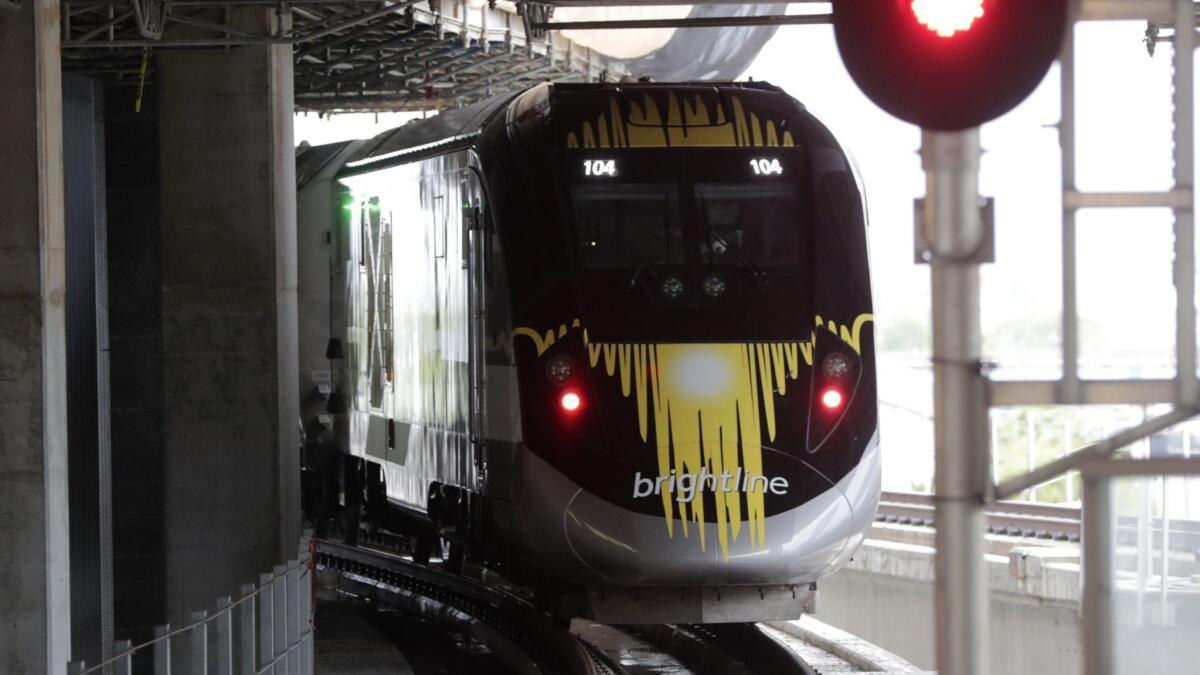Passenger rail project between Southern California and Las Vegas has a new backer

- Share via
A longstanding plan to build a passenger rail system between Southern California and Las Vegas has a new financial backer, a company operating a privately funded rail project in Florida.
Miami-based Brightline, whose rail service will connect Miami to Orlando by 2022, said Tuesday it had acquired XpressWest, the high-speed rail project that failed to get off the ground over the last decade. The terms of the deal were not disclosed.
For the record:
5:15 p.m. Sept. 20, 2018An earlier version of this story incorrectly gave an average speed for the future Brightline train between Barstow and Las Vegas rather than the Victorville and Las Vegas route. It also incorrectly stated that Brightline is currently operational between Fort Lauderdale and West Palm Beach. The line is running between Miami and West Palm Beach.
The company said it would operate between Victorville and Las Vegas on a new track along the 15 Freeway by 2022. Construction would start next year.
“Brightline is changing transportation in our country by connecting heavily trafficked corridors that are too long to drive and too short to fly,” said Wes Edens, co-founder and co-chief executive of Fortress Investment Group, which backs Brightline. “Our experience in Florida is proving that private-sector investment has a meaningful role to play in developing transportation infrastructure.”
Developers and entrepreneurs have proposed a bullet train to ferry gamblers for decades, but grand visions lacked the required capital or government backing to bankroll the concept.
In 2015, XpressWest said it had formed a partnership with China Railway International USA, a consortium led by the national railroad of the People’s Republic of China. But China never invested in the project.
Brightline says it plans to invest private equity and possibly sell investors so-called “private activity bonds” that are tax exempt. Fortress Investment controls Brightline through private management funds. Fortress describes itself as “a highly diversified global investment manager with approximately $41.4 billion of assets under management.”
The model could follow the company’s approach in Florida, where speeds are well below international bullet train speeds, costs are held down by avoiding exotic technology and private land takes are avoided. XpressWest’s plan for a 185-mile electric system was estimated at $7 billion, cheap by comparison to the California High Speed Rail Authority’s $77 billion for 500 miles of track.
But Brightline said it would significantly cut even XpressWest’s cost, aiming for a reduction of as much as 50%. It could use diesel locomotives. Speeds would be significantly slower. It would pass over major mountains, such as the Baker Grade, rather than through costly tunnels.
The company says its acquisition gives it a fully approved set of plans. But any business proposal probably would have to be modified, particularly if the technology, route or operating plan would undergo significant changes.
Another major question is the right of way. Brightline officials say they would like to go down the median of the 15 Freeway. But Bob Poole, a transportation expert at the Reason Foundation who has studied both the XpressWest and the Brightline systems, questioned whether the state would allow use of the median.
“The I-15 is an important interstate freeway and if you take away the median you are precluding the ability to later widen it,” Poole said.
Brightline is a sharp contrast to the California bullet train project, which is attempting to build a system that would be among the fastest and most ambitious in the world. The California project has so far only tapped public money and has a more than $50-billion funding shortfall.
Brightline acquired a rail right of way along coastal Florida in 2007 and sold track rights for freight to the mining conglomerate Grupo Mexico. It retained passenger track rights. When its Brightline service is completed, its diesel cars will carry passengers more than 235 miles from Miami to Orlando in about three hours.
At an average speed of 78 mph, the service does not qualify as high-speed rail, though the Federal Railroad Administration has called it “higher speed.” The advantage of such a design is in the cost — its first phase, which is in operation between Miami and West Palm Beach, is pegged at $1.9 billion.
The company also said Tuesday that it will acquire 38 acres of land along the Las Vegas strip for a station. The land would be west of the Mandalay Bay casino and most likely west of the 15 Freeway.
Brightline trains would take two hours or less to cover the 185 track miles from Victorville to Las Vegas, at an average speed of about 92 mph.
The appeal of a Victorville-to-Las Vegas system remains to be seen. From Victorville, a driver would have another three hours to Las Vegas — meaning the Brightline system might save just an hour of transit time, depending on traffic.
Eventually, company officials said, Brightline hopes to reach further into Southern California, which is not an easy or inexpensive ambition. From Victorville, the 15 Freeway drops more than 3,000 feet through the serpentine Cajon Pass.
The company did not make any passenger estimates.
Nevada and California officials issued encouraging statements about the plan.
“The introduction of high-speed rail between Las Vegas to Southern California will bring significant economic and environmental benefits to our state and support increased tourism,” said Nevada Gov. Brian Sandoval.
“California has a vision for a modernized rail network that is fast, clean, and convenient for travelers, and the introduction of Brightline service linking Southern California to Las Vegas will help us achieve that vision,” said California State Transportation Agency Secretary Brian Annis.
Follow me on Twitter @rvartabedian
More to Read
Sign up for Essential California
The most important California stories and recommendations in your inbox every morning.
You may occasionally receive promotional content from the Los Angeles Times.










